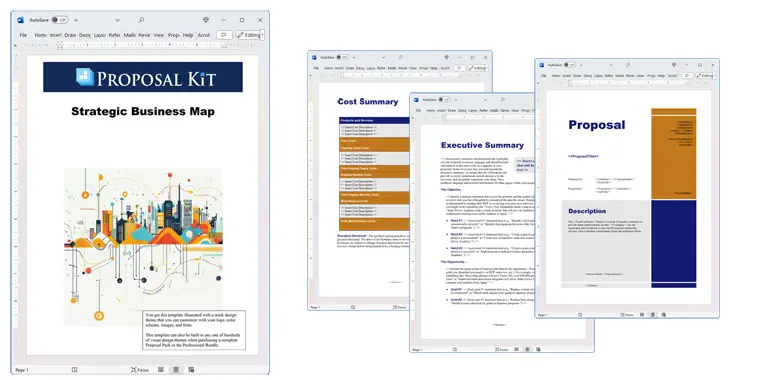How to write your Strategic Business Map
We include this 32 page layout with every Proposal Pack. If you want this template to have a different visual design theme than the one illustrated here, purchase any Proposal Pack design and create this template using the purchased design theme. This template is included in every Proposal Pack. If you get a Proposal Pack or the Professional, you can also make any variation of this template with different chapters to suit your needs.
We typically include more chapters in the templates than most people will need to give everyone more variety in the chapters they may need. You can trim down a long template by removing pages you do not need or combining multiple chapter topics into one page.
 DOWNLOADABLE, ONE-TIME COST, NO SUBSCRIPTION FEES
DOWNLOADABLE, ONE-TIME COST, NO SUBSCRIPTION FEESYou can also create countless variations of this document to suit your needs using the included library of 2200+ chapters if ordering a Proposal Pack or Professional.
 What Our Clients Say
What Our Clients SayAfter purchasing the Proposal Kit Professional, buying the proposal pack was a no brainer. It makes putting your proposal together simple with its great automation capability. It definitely save time on putting together great proposals and you should definitely get it."
Co-Principal at A&A Property Solutions, Inc.
Related Article
Related Video
Related Templates
- Business Governance Plan
- Business Strategy Change and Implementation Proposal
- Technology Strategy Analysis
- Sales Plan
- Organizational and Managerial Structure Report
- Company Profile Report
- Investment Strategy Proposal
- Strategic Plan
- SWOT Analysis Report
- Retail Location Business Plan
- Succession Planning Proposal
- Technology Business Plan
- Strategic Plan for Mobilization and Deployment of Project
- Business Plan
- Strategic Alliance Proposal
- Feasibility Study for Business Startup
- Security Survey, Analysis and Standard Compliance Proposal
- Acquisition Plan Proposal
- Business Plan Funding Request Proposal
- Business Management Proposal
- Business Model Change Planning Rolling Shutdowns Proposal
- Business Development Proposal
- Strategic Business Plan
- Company Operations Manual
- Ecommerce Proposal Template
- Human Resources Strategic Planning Proposal
- Transforming Retail Business to Service Online Proposal
- Readiness Assessment Project Proposal
- Medical Practice Startup Business Plan
- Business Case Document
- Pharmacy Startup Business Plan Funding Proposal
- BANT Sales Proposal Template
- Relocate Manufacturing Domestic Proposal
What's the Best Way to Write Your Strategic Business Map?
Creating a business map can be a challenging task, but Proposal Kit offers a proven solution with its robust set of templates and software packages. The Proposal Kit helps you outline a clear roadmap for your business, similar to a business plan, ensuring all parts of the organization are aligned to meet forward-looking goals. With the added benefit of a line-item quoting database system, this tool streamlines cost summaries, quotes, estimates, budgets, and other financial topics.
Do you need to write a business map? The Proposal Kit is designed for you. Proposal Kit is used to write reports, studies, plans as well as proposals.
What Types of Projects Are Strategic Business Maps Written For?
Business maps are invaluable for various types of projects, providing clarity and direction across numerous industries. These roadmaps are crucial for the following kinds of initiatives:
- New product launches
- Market expansion strategies
- Mergers and acquisitions
- Digital transformation projects
- Sustainability and green initiatives
- Financial restructuring
- Human resource optimization
- Supply chain enhancements
- Customer experience improvement
- Innovation and R&D projects
- Brand repositioning
- Risk management plans
- Crisis management strategies
- Community outreach and CSR programs
- Performance improvement plans
- IT infrastructure upgrades
- Strategic partnerships
- Competitive benchmarking
- Business process re-engineering
- Talent development programs
Chapters this template is built with
There is no one-size-fits-all premade template for creating a business map. This is why the Proposal Kit software offers document assembly software and an extensive content library of customizable templates designed to fit any scenario. Here's a starting point for chapters you might include, drawn from the extensive library available in the Proposal Kit:
Cover Letter
The Cover Letter introduces the business map to its readers. It sets the stage, offers a succinct overview of the document, and highlights the main message and purpose behind the plan. This section is tailored to engage stakeholders from the start, encouraging them to look into the proposal.
Executive Summary
The Executive Summary provides a concise overview of the roadmap. It underscores the primary objectives, expected outcomes, and how these topics will impact organizational growth and direction. This chapter should engage decision-makers by summarizing the most compelling topics of the plan.
SWOT Analysis
A SWOT Analysis systematically evaluates the business's internal strengths and weaknesses, as well as external opportunities and threats. This section aligns decision-making with the direction by providing a clear understanding of the business environment.
Strengths
In this section, you will detail the internal advantages and unique resources that the company possesses, which will aid in achieving objectives. These could include strong brand recognition, a skilled workforce, or proprietary technology.
Weaknesses
This chapter identifies internal challenges such as resource limitations, skill gaps, or operational inefficiencies that could hinder progress. It should also propose potential solutions to address these weaknesses.
Opportunities
Here, you will highlight external possibilities for growth, such as emerging markets, technological advancements, or changing consumer behaviors, that align with the business's goals.
Threats
Examine potential external risks, such as new competitors, regulatory changes, or economic downturns, that could impact the company's strategy. This section should propose risk mitigation strategies to safeguard the business.
Competitive Analysis
The Competitive Analysis chapter evaluates the competitive landscape to identify market positioning strategies and differentiation opportunities. By understanding competitors' strengths and weaknesses, you can create an advantage.
Industry Trends
This section discusses current market trends, such as technological shifts or consumer preferences, and how they influence the business's direction. It's crucial for aligning the business map with future market conditions.
Growth Areas
Identify potential growth areas within the business, such as expanding product lines or entering new markets. This section should align with the overall objectives and provide a roadmap for capitalizing on these opportunities.
Business Drivers
Outline the key factors driving the business forward, such as innovation, customer demand, or partnerships, and how these align with the overarching goals.
Goals and Objectives
Define specific, measurable, achievable, relevant, and time-bound (SMART) goals and objectives that will guide the business map. This chapter ensures clarity and focus on what the business aims to achieve.
Action Plan
Detail the actionable steps required to implement the strategy, including timelines, responsibilities, and milestones. This section serves as a practical guide for executing the roadmap.
Communications Plan
Develop a comprehensive strategy to ensure effective communication amongst stakeholders during the implementation of the plan. This chapter highlights the importance of transparency and information flow.
Training Plan
Outline necessary training programs to equip staff with the skills required to execute the strategy successfully. This section aligns workforce capabilities with needs.
Resource Management
This chapter plans for the efficient allocation and utilization of resources, such as finances, personnel, and technology, to support initiatives and ensure optimal performance.
Market Demand
Analyze the current and future market demand to ensure that actions are aligned with consumer needs. This section helps identify potential market opportunities and threats.
Responsibilities
Clarify roles and responsibilities to establish accountability throughout the project lifecycle. This chapter ensures that every team member understands their contribution to the plan.
Evaluation
Set up metrics and benchmarks for evaluating the success of the plan. This section provides a framework for measuring performance and making necessary adjustments.
Accountability
Establish oversight mechanisms to ensure compliance with the roadmap. This chapter is crucial for maintaining focus and discipline in executing the plan.
Recommendations
Provide informed suggestions and insights to guide decision-making processes. This section supports executive leadership in refining and adapting the plan.
Summary
Recap the business map's key points, reinforcing the plan's value and feasibility. This chapter serves as a final overview, tying together all the components of the proposal.
Company Operations
Detail any operational changes required to support objectives, such as process improvements or system upgrades, ensuring alignment with the business map.
Business Activities
Outline specific business activities necessary to achieve goals, illustrating how daily operations support the overarching strategy.
Business Development
Discuss initiatives for developing business opportunities and fostering growth, such as partnerships, new markets, or innovative products aligned with objectives.
Strategic Position
Define the organization's position within the industry context, focusing on competitive advantages and core competencies that differentiate the business.
Competitiveness
This chapter enhances competitive advantage through initiatives and positioning, ensuring the business remains agile and resilient in a dynamic market.
Business Model
Outline the existing or proposed business model that supports objectives, demonstrating how the business creates, delivers, and captures value.
Business Map
Present a visual or narrative description of the roadmap, linking all components together to provide a cohesive overview of the business map.
Use cases for this template
Standing Out in a Crowded Market
The Challenge
At Innovate Corp, Samantha was tasked with a challenge: to create a proposal that would capture the attention of investors in a fiercely competitive industry. With the clock ticking, she knew that the proposal needed to be not only compelling but also detailed to pitch their groundbreaking new product.
The Solution
Samantha turned to Proposal Kit for a solution that offered more than just a template. Before the proposal could be written a business map was needed. The Proposal Kit provided an extensive array of customizable tools perfectly suited to the unique needs of Innovate Corp. The business map templates were particularly beneficial, as they allowed Samantha to concentrate on the content and messaging of the proposal without getting bogged down by format concerns.
The Implementation
Harnessing the power of Proposal Kit's comprehensive templates, Samantha was able to quickly build a sturdy proposal framework. By systematically addressing each part of the business plan - from SWOT analysis to financial projections - she ensured that every critical topic was thoroughly covered. The software's features enabled her to maintain a high level of precision and clarity throughout the document.
The Outcome
The finished map was a testament to clarity and depth, impressing potential investors with its thoroughness and foresight. Innovate Corp not only secured the necessary funding but also positioned itself as a leader within the industry. Samantha's adept use of the Proposal Kit was instrumental in achieving this success, highlighting the tool's effectiveness in navigating competitive landscapes.
Beating the Clock for IT Transformation
The Challenge
James, an employee at Tech Works, found himself under pressure as he faced a approaching deadline. His task was to write an internal proposal aimed at overhauling the company's IT processes - a key step in Tech Works' broader digital transformation initiative.
The Solution
Recognizing the urgency and importance of the task, James turned to Proposal Kit. This choice provided him access to a wealth of templates and an integrated Wizard software program. These resources were further enhanced by an AI writing tool, which James used to refine his writing process, ensuring both speed and precision.
The Implementation
With the user-friendly interface of Proposal Kit, James efficiently constructed a business map tailored specifically for Tech Works. The AI tool was deployed to analyze content from the company's website, which helped James create relevant and precise content across each chapter of the proposal. This integration of technology and strategy streamlined the entire writing process.
The Outcome
Thanks to the Proposal Kit, James was able to meet the tight deadline with ease. The proposal received swift approval from management, leading to a successful implementation of streamlined IT processes. This, in turn, resulted in notable efficiency improvements within the company. The use of Proposal Kit's templates played an important role in facilitating this outcome, demonstrating the tool's capability to meet high-pressure internal demands.
Building Bridges for Environmental Change
The Challenge
At Green Future, a non-profit dedicated to environmental awareness, Martha held the vital role of director. She faced the challenge of creating a Request for Proposal (RFP) to attract partners for a new sustainability initiative critical to the organization's mission.
The Solution
Martha chose Proposal Kit to fulfill this need, confident in its ability to deliver both structure and content. The extensive library of templates allowed her to create an RFP that was perfectly aligned with Green Future's objectives and vision.
The Implementation
With Proposal Kit at her disposal, Martha created an RFP, ensuring that every facet of the business plan met potential partners' expectations. She used the customizable templates to highlight Green Future's unique strengths and goals, making a strong case for collaboration on the sustainability initiative.
The Outcome
The RFP generated significant interest, leading to successful partnerships that furthered Green Future's mission. The business map demonstrated the non-profit's dedication to sustainability and made an argument for partnership. The Proposal Kit proved important in creating a winning proposal, enabling Martha to communicate her organization's vision and objectives.
Conclusions and Recommendations
In conclusion, the key to creating a successful business map lies in using a proven tool like Proposal Kit. Whether you're navigating industry challenges, meeting tight internal deadlines, or securing partnerships for growth, Proposal Kit helps you with templates and a systematic approach to achieving your business goals. The comprehensive solution aids in aligning organizational objectives and strategies, ensuring your roadmap is both clear and actionable.
Also Known As
This template may also be referred to in different ways or be used in more specialized situations, such as:
- Business Roadmap
- Strategic Plan
- Company Strategy Blueprint
- Organizational Roadmap
- Executive Strategy
- Business Direction Plan
- Company Growth Map
- Enterprise Strategy Guide
- Business Alignment Strategy
- Corporate Roadmap
Abstract
 A strategy map is an important visual tool that helps organizations articulate their objectives and connect them to actionable business objectives through clear cause-and-effect relationships. By translating an organization's vision and core values into a single-page diagram, a strategy map provides a clear visual representation of the overall strategy and direction, aligning various internal business processes and goals. Using the four perspectives of the balanced scorecard - financial perspective, customer perspective, internal processes, and learning and growth - this approach enables managers to assess and monitor both financial and nonfinancial variables that drive performance and revenue growth.
A strategy map is an important visual tool that helps organizations articulate their objectives and connect them to actionable business objectives through clear cause-and-effect relationships. By translating an organization's vision and core values into a single-page diagram, a strategy map provides a clear visual representation of the overall strategy and direction, aligning various internal business processes and goals. Using the four perspectives of the balanced scorecard - financial perspective, customer perspective, internal processes, and learning and growth - this approach enables managers to assess and monitor both financial and nonfinancial variables that drive performance and revenue growth.
Through effective strategy map creation, organizations can pinpoint areas for operational efficiency, enhance employee training and engagement, and foster cross-functional awareness, ensuring the entire team works toward achieving organizational goals and ambitious company objectives. The balanced scorecard software and strategy software available in the market streamline the process, making it easier to set priorities, organize execution activities, and track the accomplishment of specific objectives and initiatives across different business areas. Whether in healthcare, nonprofits, or various industries, an effective strategy map tells the story of the business's journey, identifies growth objectives, and represents big-picture objectives in an immediately apparent visual format. By continuously revising the map to reflect changing circumstances and organizational strategy, companies can realize continuous improvement, invest in the right measures, and adapt to future directions. The primary purpose of a strategy map is to help organizations focus efforts, set targets, and use valuable insights from key stakeholders to achieve value, competitive advantage, and profitability. Strategy development and performance monitoring become more productive and insightful, enabling organizations to contribute meaningfully to business success and manage priorities.
Management requires more than just a basic strategy map. Most companies seek ways to improve strategy execution and achieve goals by fostering organizational involvement and ensuring all employees are on the same page. When organizations create a strategy map, they not only clarify critical objectives in a visual format but also help translate complex strategy development into clear action items and action verbs, making it easier for teams to understand their roles. By representing key categories and perspectives - financial, customer, internal processes, and learning and growth - strategy maps enable managers to describe the connections between different objectives, highlight causal relationships, and track progress toward financial goals and customer goals alike.
 A well-constructed strategy map provides detailed information that helps organizations determine priorities, shape organizational capacity, and visualize the journey from the current state to long-term objectives. The inclusion of a customer value proposition and value proposition in the map ensures a focus on how the business intends to deliver quality services and meet customer needs. For example, in green-based initiatives or sustainability projects, the strategy map can highlight how such efforts affect both operational topics and the organization's broader culture.
A well-constructed strategy map provides detailed information that helps organizations determine priorities, shape organizational capacity, and visualize the journey from the current state to long-term objectives. The inclusion of a customer value proposition and value proposition in the map ensures a focus on how the business intends to deliver quality services and meet customer needs. For example, in green-based initiatives or sustainability projects, the strategy map can highlight how such efforts affect both operational topics and the organization's broader culture.
The Proposal Kit, with its extensive content libraries and document assembly capabilities, gives strategy leaders a simple guide to formulate and revise effective strategy maps. It supports creative thinking by offering templates that prompt consideration of different perspectives and the preceding perspectives that influence outcomes. This helps to explore ideas, incorporate feedback, and adapt to the reality of changing markets and internal capacity, even over the course of years. Using Proposal Kit, managers can quickly build strategy maps that reflect the organization's intent, provide helpful examples, and encourage continuous improvement by revisiting and updating the map as needed.
By using Proposal Kit rather than relying solely on other tools, organizations can more efficiently organize, track, and monitor performance, ensuring that the critical topics of their overall organizational strategy are addressed. The process helps drive productivity, promote employee engagement, and support the achievement of both short-term targets and long-term goals across different business areas. Finally, the ability to formulate and communicate a strategy map that brings together all four areas of the balanced scorecard perspectives is imperative for modern management, empowering organizations to realize their ambitions, adapt to feedback, and deliver sustained value in their respective industries.
 Most companies find that integrating financial customer internal processes into their organization's strategy not only enhances clarity but also improves tracking of results across various jobs and departments. When developing their first strategy map, leaders often realize the difference this tool makes in aligning perspectives - whether focusing on two perspectives, such as financial and customer or expanding to include all balanced scorecard areas. Over the course of even years, a well-written strategy map continues to provide value by serving as a living document that can be updated to reflect changes in data, business life cycles, and the reality of shifting markets.
Most companies find that integrating financial customer internal processes into their organization's strategy not only enhances clarity but also improves tracking of results across various jobs and departments. When developing their first strategy map, leaders often realize the difference this tool makes in aligning perspectives - whether focusing on two perspectives, such as financial and customer or expanding to include all balanced scorecard areas. Over the course of even years, a well-written strategy map continues to provide value by serving as a living document that can be updated to reflect changes in data, business life cycles, and the reality of shifting markets.
The concepts behind a strategy map are designed to help those involved in strategy development and execution visualize both short-term and long-term priorities. This article highlights how integrating perspectives of financial customers within a single visual document helps decision-makers base their actions on reliable information. As new data emerges and organizational needs evolve, the strategy map can be revised, allowing leaders to maintain focus on what matters most and ensuring the strategy map reflects current aims.
Finally, by regularly revisiting and refining the strategy map, organizations ensure that strategy execution remains dynamic and relevant over time. This process encourages involvement across all jobs and functions, reinforcing the importance of continuous tracking and adaptation. In summary, using a strategy map, as described in this article, supports the practical application of concepts in day-to-day life and throughout the broader journey toward organizational excellence.
Frequently Asked Questions
What is a business map, and how does it differ from a traditional business plan?
A business map is a dynamic and visual representation of a company's goals and the paths to achieve them. Unlike a traditional business plan, which primarily focuses on detailed planning and financial projections, a business map emphasizes alignment and direction, ensuring all organizational parts move cohesively toward shared objectives. It typically highlights key goals, actions, and resources in a more flexible, adaptable format.
How do I start creating a business map for my organization?
To create a business map, begin by clearly defining your organization's mission and objectives. Identify key components such as strengths, weaknesses, opportunities, and threats (SWOT analysis), as well as competitive analysis and market trends. Using a tool like Proposal Kit can simplify this process by providing structured templates that guide you through each component, ensuring a comprehensive approach to mapping your business strategy.
What components should be included in a business map?
A well-rounded business map should encompass various components, including an executive summary, SWOT analysis, industry trends, business drivers, and goals and objectives. Additionally, it should outline an action plan, communications plan, and resource management strategies. Proposal Kit offers customizable templates for each of these components, ensuring that your business map is thorough and tailored to your organization's needs.
How can a business map help improve organizational alignment?
A business map serves as a roadmap that aligns all departments and stakeholders toward common goals. By clearly outlining the direction and expected outcomes, it ensures everyone understands their roles and responsibilities. This alignment enhances communication, fosters collaboration, and helps maintain focus on achieving the organization's long-term vision, which is integral to successful implementation.
Can Proposal Kit be used for creating a business map for any industry?
Yes, Proposal Kit is and can be adapted to create a business map for any industry. Its extensive library of templates covers a wide array of situations and project types, from product launches to digital transformations. By using these customizable resources, organizations across various sectors can construct business maps that address their unique challenges and opportunities.
20% Off Discount
![]() Add To Cart This Word Template
Add To Cart This Word Template
 Add To Cart Proposal Pack for Any Business
Add To Cart Proposal Pack for Any Business
 Add To Cart Proposal Kit Professional
Add To Cart Proposal Kit Professional
 4.7 stars, based on 849 reviews
4.7 stars, based on 849 reviewsProposal Kit chapters used in this template
Cover Letter, Title Page, Table of Contents, Executive Summary, Business Map, Goals and Objectives, SWOT Analysis, Strengths, Weaknesses, Opportunities, Threats, Business Drivers, Industry Trends, Growth Areas, Business Development, Competitive Analysis, Market Demand, Action Plan, Communications Plan, Training Plan, Resource Management, Responsibilities, Accountability, Evaluation, Company Operations, Business Model, Business Activities, Strategic Position, Competitiveness, Recommendations, Summary, Back Page
You use this proposal for
- General business proposal
- Non-technical proposal
- Project pitch proposal
- Business plan, loan, investor funding proposal
- Internal company proposal
- Business document, study, plan, report
How to create this template with Proposal Pack Wizard
You can create this document using any of the logo-designed Proposal Packs. Pick any Proposal Pack with a logo design theme you like best; they will all work equally well. The Proposal Pack for Any Business is the pack with no extra added logos or colors - designed to be used plain or for you to customize with your logos and graphics.
The Proposal Pack design theme you purchase will determine the visual look of this template. The screenshot above only shows the plain generic design theme.
We include a library of chapters to be assembled based on your needs. All proposals are different and have different needs and goals. We designed Proposal Pack so you can customize the documents to suit your needs.
You will best create this document using the Proposal Pack Wizard - Expert Edition software to select this template and build it in the Proposal Pack logo design theme of your choice along with any desired customizations (such as adding additional chapters, removing unneeded chapters, changing the order of chapters, and importing your company logo). This template outlines a proposal for the described situation. Each user is responsible for typing in the actual content of the provided pages with their information to complete the proposal. Suggestions in the abstract may include features in higher-end packages and are facilitated by the selection of chapter templates to support the narrative of each proposal, which help guide the user in filling in the details.
The Wizard software's AI Writer will write the content of the pages of the template based on details provided for your company, client, project, financial details and other writing instructions. This will provide a personalized version of the template completely written and ready to edit.
Once finished, the AI Writer's Word-to-PowerPoint converter can transform your proposal, business plan, or other business documents into a PowerPoint slideshow. Save time and effort by letting the AI analyze every chapter to condense its content into talking points, visually matching the document, and providing a consistent package of presentation material with the click of a button.
You create this template using the Wizard software with an entire Proposal Pack library and software. We include the Expert Edition of the software in the Proposal Kit Professional. Microsoft Word for Windows is required to use the customizing software. You can also edit Word document templates in other office software such as Word for Mac. We will assist Mac users in assembling complex templates for their first project if they do not have the required platform to run the Wizard software.
How to Build Templates Featured on Proposal Kit Website
Many people find the Proposal Kit website after searching for a specific proposal. Once you've purchased and installed the software, how do you build that template you found in the first place? This video shows you how to build any proposal you see on the Proposal Kit website.
 Ian Lauder has been helping businesses write their proposals and contracts for two decades. Ian is the owner and founder of Proposal Kit, one of the original sources of business proposal and contract software products started in 1997.
Ian Lauder has been helping businesses write their proposals and contracts for two decades. Ian is the owner and founder of Proposal Kit, one of the original sources of business proposal and contract software products started in 1997.By Ian Lauder
 Published by Proposal Kit, Inc.
Published by Proposal Kit, Inc.


 Cart
Cart
 Get 20% off ordering today:
Get 20% off ordering today: 


 Facebook
Facebook YouTube
YouTube Bluesky
Bluesky Search Site
Search Site